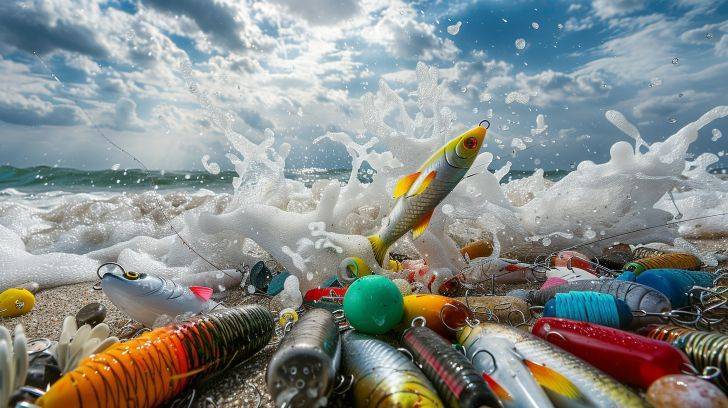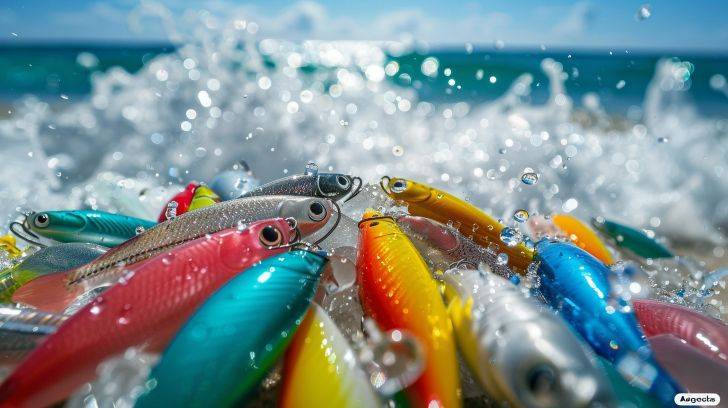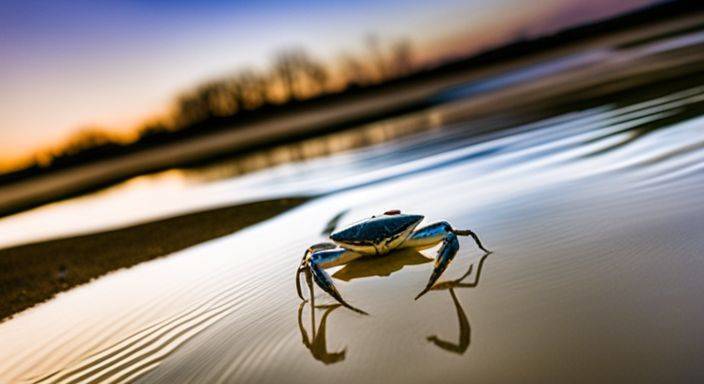Ever caught yourself standing on the shoreline, fishing rod in grip, puzzling over which bait might coax those elusive surf dwellers to nibble? Oh, I get it – gazing into the ocean’s expanse can leave you baffled.
But after immersing myself in a sea of information and many sunrises spent testing out various baits along the coast, I’m primed to share some wisdom that could elevate your fishing game from hopeful casting to celebrating catches.
We’re going to uncover ten baits that can transform an afternoon of guesswork into moments of angler glory. So gear up and let’s unearth that magical lure!
Shrimp: A Top Choice for Surf Fishing

When I think back on all my early mornings on the beach, rod in hand and hope in my heart, it’s often a plump juicy shrimp that I’ve threaded onto the hook before casting into the surf.
There’s something irresistible about shrimp to those feisty fish—it’s like they’re part of an unwritten oceanic pact to come running—or swimming—whenever these little crustaceans hit the water.
Features & Usage of Shrimp Bait
I love using shrimp bait for surf fishing. It catches all kinds of fish and it’s perfect for beginners like us. You can choose live shrimp, frozen ones or even artificial lures that look like shrimp.
Each type has its own special way to hook and use. For example, you might tail hook a live shrimp so it swims naturally, or thread a frozen one onto a jighead.
Now let’s talk hooks – they matter a lot! I tend to go with the Owner Mutu Lite or Gamakatsu Octopus hooks; they’re sharp and strong enough to handle big fish. And if you don’t want the mess of real shrimp, try Fishbites.
They mimic natural baits without the fuss and stay on your hook in rough surf. Plus, cut bait pieces work great when you’re chasing after those larger predators during summer months – think tarpon or sharks!
Sand Fleas: Perfect for Saltwater Species

If you’re new to surf fishing and after those coveted saltwater trophies, then let me tell ya—sand fleas are like a secret handshake with the ocean; they offer that magical combination of scent, texture, and size that seems almost irresistible to species like pompano and red drum.
Dive in deeper into my blog where I spill the beans on how these tiny critters can up your surf fishing game—you won’t want to miss out!
Features & Usage of Sand Fleas Bait
I always keep an eye out for sand fleas when I hit the beach. These little critters work wonders as bait. They’re tough, so they stay on the hook when waves crash around. You’ll find them in the wet sand where waves come up to shore.
A quick scoop with a sand flea rake can land you plenty of these baits.
Hooking them is simple too: just push the hook through their shell or use their knuckles. Freshly caught or frozen, both do the trick to lure in species like pompano that love munching on these snacks.
Plus, if real ones are hard to find, there’s always artificial lures shaped just like them – quite handy for any surf fishing trip!
Cut Bait: Ideal for Large Predatory Fish

When I’m out there on the surf, with the salt spray in my face and that hopeful tug on the line, cut bait is my go-to for tempting those big bruisers lurking beyond the breakers. It’s a slice of fish heaven—literally—that brings in everything from voracious sharks to line-peeling blues, tapping into their instinctual drive for an easy meal.
Features & Usage of Cut Bait
I always keep cut bait on hand for those big predatory fish. Smaller fish like whiting and mullet work great when I’m after the monsters of the deep. I make sure to slice them into chunks or strips that will fit nicely on my hook.
It’s not just about cutting up some fish; it’s choosing the right size to match what big predators are used to eating.
Hooking cut bait properly makes all the difference too. Strong circle hooks ensure that once a fish bites, it stays caught. And matching the hook size to my bait is key – too small and it gets stolen, too large and it scares the fish off.
Every time I cast out with cut bait, I feel confident that something powerful will take notice.
Blue Crab: Attractive to Variety of Fish Species

Let me tell you, there’s something irresistible about blue crab that just draws in a myriad of fish species when I’m surf fishing. Whether it’s the scent or the meaty goodness, tossing out a piece of this crustacean often leads to some exciting bites – an absolute feast for both large and small predators lurking beneath those waves.
Features & Usage of Blue Crab Bait
I’ve had great success with blue crab bait in surf fishing. It’s a fantastic option for beginners because it lures so many different fish species. You can cut the crab into pieces or use just the legs to make knuckles, which are irresistible to fish like big bull redfish and sharks during summer months.
The meat is rich and full of scent, making it hard for fish to ignore.
For the best results, I pair blue crab bait with top-notch hooks like Owner Mutu Lite or Gamakatsu Octopus. These sturdy hooks help me land the catch without fail. In my tackle box, blue crab always has a place — whether I’m targeting something specific or casting out hoping to see what bites.
Trust me, tossing some chunks of this versatile bait into the surf can turn an average fishing trip into an unforgettable day on the water.
Clams: Effective in Attracting Surf Fish
When I wade into the surf with a pocket full of clams, it’s like ringing the dinner bell for all those discerning fish hunting through the sand – they simply can’t resist the succulent morsels, and neither should you in your quest for that epic catch; curious how to make these shellfish work wonders on your line? Keep reading.
Features & Usage of Clams Bait
I always make sure to have clams on hand for surf fishing, especially when I’m targeting species like pompano or flounder. Their natural scent and texture are irresistible to many saltwater fish.
You’ll find me taking the clam meat out of its shell and carefully threading it onto my hook. Sometimes, I even crush the shells and toss them into the water as chum.
Clams work wonders in both peaceful waters and active waves, making them a go-to bait no matter what the surf conditions are. If I want to mix things up, I pair clams with other baits such as sand fleas to create an even more tempting snack for those fish.
Trust me, seeing your line tighten because a big one took your clam bait is an experience you won’t forget!
Squid: Versatile Surf Fishing Bait
Ah, squid – it’s like the Swiss Army knife of baits in my surf fishing arsenal. Whether I’m after those finicky pompano or a school of hungry reds, this cephalopod delivers with its tantalizing tentacles and robust scent.
You’ll find that its versatility isn’t just hype; cut into strips, chunks, or used whole, squid has a knack for attracting a variety of species from the surf line to beyond.
Features & Usage of Squid Bait
I always keep squid in my tackle box for surf fishing. It’s a superstar bait that hooks Pompano, Whiting, and even Spanish Mackerel. Squid’s tough skin clings to the hook like glue, so those sneaky little fish can’t easily steal it.
You’ll find squid at most local bait shops or food markets.
Now let me tell you about rigging this versatile critter – there are countless ways! Chop it into strips or use whole pieces; either way gets you bites. When big Redfish prowl the shallows, I thread a chunk onto my fish finder rig and cast it out past the breakers.
The waves do their dance, but that squid stays put until a hungry mouth finds it.
Fishbites: Synthetic Alternative to Natural Baits
While old-school surf anglers might raise an eyebrow, I’m here to tell you that Fishbites—a synthetic bait option—are making quite the splash in the shore fishing scene. Imagine not having to deal with the mess of natural baits yet still pulling in catch after catch; it sounds almost too good, but trust me—these strips have a knack for fooling even the wariest of fish with their long-lasting scent and flavor release.
Features & Usage of Fishbites Bait
I always keep Fishbites bait on hand for my surf fishing trips. It’s a synthetic alternative that’s super easy to use, especially when I don’t have time to find natural bait. With Fishbites, I just match it to the local prey and I’m ready to catch fish like tarpon and sharks.
Its concentrated formula means it stays on the hook longer, even in rough surf.
Here’s a tip: pair Fishbites with live bait for an unbeatable combo. For hooks, I go with Owner Mutu Lite or Gamakatsu Octopus because they work best with this kind of bait. Trust me, you’ll see how effective it can be at pulling in those larger fish without too much hassle!
Live Baits: For Targeting Specific Fish Species
When I’m laser-focused on bagging a particular type of fish in the surf, nothing beats live baits; they bring out the hunter in your target species like nothing else.. Stay tuned to discover how to wield this advantage for an epic day by the waves.
Features & Usage of Live Baits
Live baits work like magic for targeting specific fish species. I make sure to pick the best live bait for the fish I’m after. For strong swimmers like yellowfin croaker or black drum, small fish such as finger mullet are great.
They wiggle and kick, sending signals that drive predatory fish wild.
Hooking them correctly is crucial so they stay alive longer. I go through the lips or nostrils, or sometimes gently insert the hook near the tail’s base if I want a different action in the water.
The key is keeping them lively to attract attention in deeper water or during high tide when surf fishing gets challenging. Live baits really shine then – nothing beats their natural movement and scent!
Crabs: Suitable for Catching Bigger Fish
When it comes to hooking those trophy catches right off the surf, crabs are your go-to bait—trust me on this. They’ve got a unique appeal that’s irresistible to larger game fish; something about those wriggling legs and tough exoskeletons just draws them in like a dinner bell for predators.
Features & Usage of Crabs Bait
I’ll tell you, crab bait is a game-changer for surf fishing. In the summer, I use the fleshy parts of crabs to hook some serious fish like tarpon and sharks. You just take those crab legs or knuckles and get them on a circle hook.
It’s that simple, yet so effective.
Now, if you’re aiming to catch bigger fish right from the shore, crabs are your best bet. Beginners can really up their game with this technique. Every time I hit the beach with my rod and some fresh crab bait, I feel confident about reeling in something impressive.
Plus, it’s not just about luck; using crab bait well is a skill that gets better with practice.
Popular Bait Rigs for Surf Fishing
Surf fishing rigs can make a big difference in how many bites you get. Choosing the right rig helps present your bait naturally and improves hook-up rates. Here are some popular surf fishing rigs:
- The Carolina Rig: This simple setup uses a sliding sinker above a swivel, followed by a leader and hook. It’s great for bottom feeding fish because it keeps the bait near the sand.
- A Pompano Rig: Made with two or more hooks that branch off from the main line using dropper loops, this rig targets Pompano but catches other species too. You attach your weight to the very bottom.
- The Dropper Loop Rig: Similar to the Pompano, it features several hooks off one main line; ideal for fishing multiple baits at varying depths.
- A Fish Finder Rig: This one has a loose-fitting sinker on the main line so fish can take bait without heavy resistance.
- The High/Low Rig: With hooks attached above and below the weight, this rig lets you try two different baits at once.
Best Hooks for Surf Fishing
I always make sure to bring the right hooks for surf fishing. They can make a big difference in hauling in that catch. Here’s what I’ve learned about choosing the best hooks:
- Choose the Owner Mutu Lite hook for a versatile option. These hooks are strong yet lightweight, making them perfect for a variety of surf species.
- Go with the Gamakatsu Octopus hook if you’re targeting larger fish. Their sharpness and durability give you an edge when fighting big game.
- Circle hooks are great for conservation efforts. They tend to hook fish in the corner of the mouth, which is ideal for catch and release.
- J – hooks work best when you need a quick and solid set, especially useful during high wave action or when using heavier tackle.
- Size matters – smaller hooks for small baitfish and larger ones for chunky cuts of bait; match your hook size to your target species.
How to Enhance the Success of Surf Fishing
Surf fishing is a thrill, but it also demands skill and knowledge. To elevate your success on the sandy beaches, here are some effective strategies:
- Match your bait to what the fish are eating in that area; local tackle shops can give you tips on the right bait.
- I use circle hooks for better hook sets and fewer swallowed hooks; it makes releasing fish easier too.
- Keeping an eye on water temperatures helps me pick the best times to fish; warmer waters often mean more active fish.
- High tide and low tide each offer unique opportunities; I’ve found outgoing tides especially productive.
- Cast farther with longer rods and practice your technique for even longer casts; reaching deeper water sometimes lands bigger fish.
- Observe birds like seagulls or pelicans; they dive when they spot schools of bait fish, which means predators might be nearby.
- Experiment with both live and dead baits to see what works best; sometimes inactive prey items attract more bites.
- Staying patient is key, even if bites seem slow at first; many factors including time of day affect fish activity.
- Setting up near sandbars or troughs can improve catch rates as these structures often hold fish.
- Utilize sand spikes to keep your rod stable and ready when those strong surf species hit your line hard.
- Fluorocarbon leaders are less visible underwater than other lines; using them might fool wary fish into biting.
- Keep fresh bait at hand since its scent and texture often outperform older, less enticing options.
- Scouting a spot before setting up can lead to better results since not all stretches of beach are equally fruitful.
Choosing the Best Bait for Surf Fishing
I always look for the best surf fishing bait to fill my cooler with fish. The choice depends on what’s biting and where I’m casting. For example, sand crabs are a surefire hit in southern California.
There’s nothing like seeing a striped bass smash live bait right in the surf zone! Sometimes, I switch it up and go with blood worms or fresh shrimp if that’s what locals say is working.
Big baits can reel in big rewards. Hefty chunks of cut bait might just land you a shark during those hot summer nights. It’s thrilling when my line goes tight because something huge has taken the bait—good times! Always match your tackle to the bait; light tackle won’t handle heavy rod demands when large fish are involved.
Whether it’s mole crabs or soft plastics, having various options makes sure you’re ready for anything that swims along the coast.
Essential Tips for Using Surf Fishing Baits
Using the right surf fishing baits is key to a great day at the beach. Here are some tips I’ve learned that can help you catch more fish.
- Match the hatch, because fish eat what’s around them. Look at what’s in the water where you’re fishing and choose your bait accordingly.
- Keep your shrimp fresh; it makes a big difference. Use ice to keep shrimp cool and change them often to stay appealing to fish.
- Hook sand fleas through their shell so they stay alive longer. This trick helps attract fish with their natural movements.
- Clams should be hooked through the tough muscle. It prevents them from being washed away by waves or pecked off by small fish.
- Create blue crab knuckles by breaking off the claws and legs. Attach these pieces securely on your hook for an irresistible snack.
- Use Fishbites when live bait isn’t working or available. They last a long time and can be just as effective without the mess.
- Store live baits in conditions close to their natural environment. Keep them cool, moist, and aerated for best results.
- Cast past the breakers where bigger fish feed if you’re after a prize catch. This area is often where the action happens.
- Switch up your baits based on what’s biting during different seasons or times of day. Fish preferences can change with conditions.
- If you’re new to surf casting, start with lighter tackle to get a feel for it before moving up.
- A sharp hook ensures better penetration — check and replace dull hooks regularly.
- Consider tide times; some species feed more actively during high or low tides.
- Rinse your baits of human scent – handling bait less or using gloves might increase your chances of success.
- Always observe local regulations about bait usage; some areas have restrictions on certain types of bait.
Conclusion
Alright, let’s reel it in. Choosing the right bait can make or break your surf fishing adventure. Remember, match the hatch and watch as your line dances with every bite. Freshness counts; so does hook size—get these right for a bucket full of success! And hey, don’t shy away from synthetic baits like Fishbites—they’re clutch when live bait’s not on hand.
Here’s to tight lines and stories of the one that didn’t get away!
